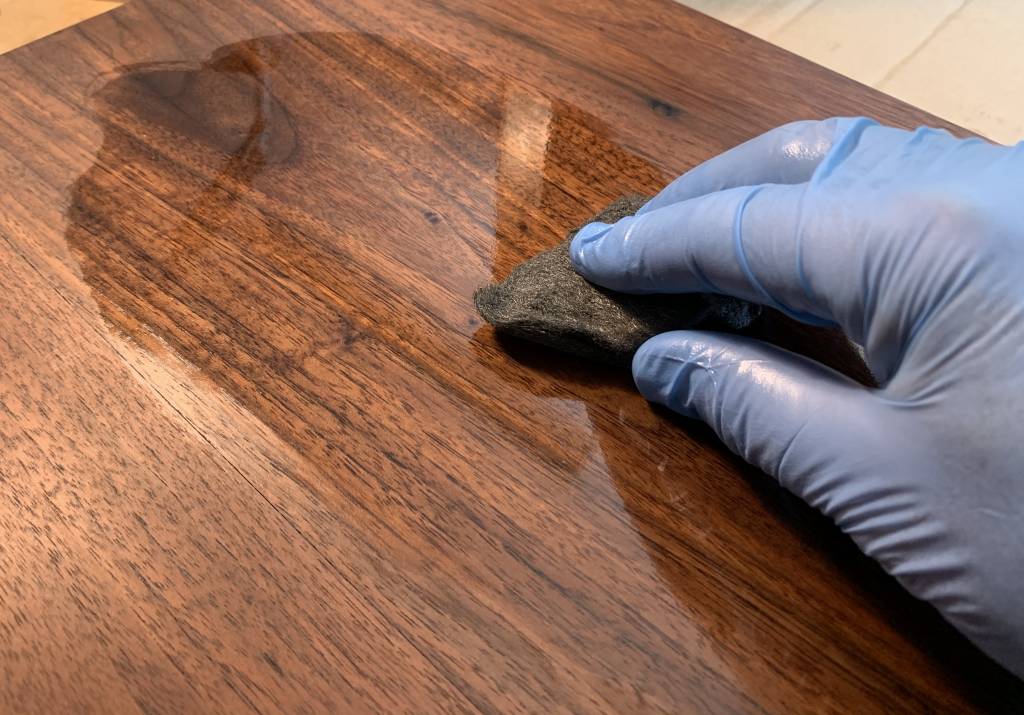
Photo credit: K. Rummer
Feeling steadier now
What I learned from walnut and light
by Ken Rummer
The bench seat feels smooth under my hand. Finally. It’s been a journey.
The three walnut boards that form the seat started out rough-sawn, still sporting splinter fuzz and tooth arcs from the sawmill. I brought them through jointing and planing and edge gluing. I cut the panel to final size and angled the edges by 10 degrees. I filled knots with blackened epoxy and then worked up through three grits of sandpaper. I thought it was time for finish.
But when the first coat of Danish oil glistened on the wood, a depression appeared like a trench across the whole panel, a remnant of planer snipe. (Insert expletive of dismay.)
A board is drawn through the planer by two rubber rollers. But toward the start and finish of a pass, when only one roller is in contact with the board, the end can lift just a bit into the spinning knives. That deeper cut, the bane of woodworkers, is called snipe, and I was seeing it across the seat of my bench.
Declare it good enough? Or try to make it better? That decision comes up a lot in woodworking. This time I chose the second path.
Backtrack. Redo. Deploy the scraper to remove the finish and the ridge along the snipe. Then re-sand with the finer two grits.
Now, reading the surface like a Braille page, my fingertips find a satisfying smoothness with a micro-texture like velvet, and no trench.
I feel steadier, with my hand on the wood.
Into the sixth week of hiding out from the virus, we are still holed up in our house, with a few exceptions for things like walks and groceries.
I thought I was doing pretty well with all the changes — not going to church, not eating in restaurants, not seeing friends and family in person. But when we passed the one month mark, I noticed an inner shifting. Maybe the newness of all the adjustments was wearing off. Maybe the reality of the situation was finally setting in. Maybe the rising curves of infection and the weekly waves of unemployment and the mounting toll of deaths passed some threshold in my emotional apparatus. Whatever the reason, I’ve been feeling out of sorts, sluggish and edgy and unsettled.
But out in the garage, in the shop, my hand resting on the wood, I feel steadier.
The boards in this bench seat have some age to them. They grew in walnut trees for sixty or eighty years. Cut down and sawmilled into rough planks, they dried in the mill shed for some years more. On the death of the sawyer, they came by auction sale to a friend’s basement shop. Twenty years and a flash flood later, they came to me as a gift, and that was almost two years ago now. So by my rough estimation, the oldest rings of the wood beneath my fingers go back a century or more.
That means they went through the world flu pandemic in 1918. And they witnessed the peak of the polio epidemic in the 40s and 50s. No wonder they seem to be taking the COVID-19 virus in stride.
It occurs to me that all this wood I see grew in darkness, layer by layer, behind blackout curtains of bark. In darkness it remained within the boards, to be brought to light at last by the final slice of the plane, the ultimate shave of the scraper.
I’m the first to see this surface of wood in all the history of the world. (Unless the God of the universe can look as easily into the hearts of trees as into human hearts.)
As I soak a steel wool pad in finish and begin to rub it in, I take another look. Though these walnut fibers have spent years in darkness, they overcome their shyness and invite the light to dance. The light smiles and says I’d love to, and off they go, twirling and dipping along mysterious ribbons of grain, skipping lightly past knot and pith, and scattering in their wake glintings of gold and flecks of holy fire.
The book of the prophet Isaiah declares:
The people who walked in darkness
have seen a great light;
those who lived in a land of deep darkness—
on them light has shined.
—Isaiah 9:2 NRSV
Drawing courage from wood and word, I extend a proper hand, palm up, and ask the light to dance.

Ken Rummer writes about life and faith from the middle of Iowa by the High Trestle Trail. His previous posts may be viewed at http://presbyterianmission.org/today/author/krummer